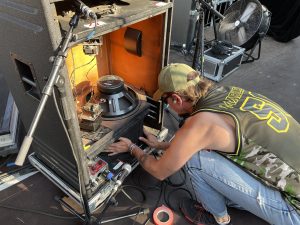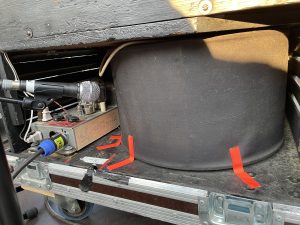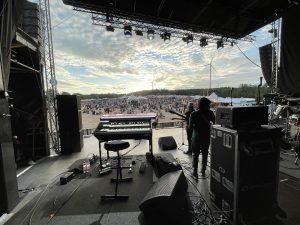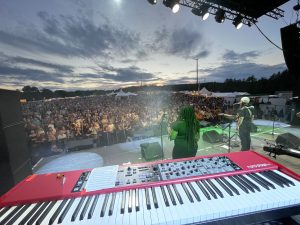Art of Reggae founder Matt Jenson is on tour throughout Europe with GROUNDATION, July and August, 2022. In support of the band’s 10th album release, ONE ROCK. LISTEN TO IT HERE!
More Groundation tour info:
http://www.groundation.com/live
I’m going to post updates on the tour on this one blog post but you can see LOTS of pictures and videos on my itsmattjenson INSTAGRAM and my personal FACEBOOK PAGE.
July 15: I’m sitting on the bus, in my sleeping birth, writing. I’m 6’4″ and believe it or not, I actually fit, and can sleep. We arrived in Paris on the 8th and did 5 days of rehearsals, HARD rehearsals. It’s one thing to record an album and QUITE another to prepare the music for live performance. Previously in the band there was another keyboard player who was playing mostly rhythm piano/E.piano and I was left playing the organ (and the band carries a REAL Hammond B3 and leslie – what a pleasure!) and some e.piano and synth parts. Now I’m the only keyzie so it’s a lot of work. And the MOST important thing is keeping the hard core chop and bubble going at all times! It’s hard to put into words how important it is for this to be in place. Ya can’t miss a beat and gotta be absolutely LOCKED with bassie and drummie. Check the lessons on reggae piano and organ playing!
ORGAN issues: Something is wrong with our Hammond organ. The output level is quite low. I’ve put in a request for help with the Berklee College organ tech. Hoping we can fix this. These are antique instruments, even though the Groundation B3 has been ‘chopped’ and modernized, it’s still made up of tubes, resistors, lead wheels and all kinds of 1940-60’s materials, prone to breaking down. And issue with the bubble on a REAL B3: you think it’d be the best sound ever because it was pretty much invented on the organ, but there’s something about the tone of that strength of the tone when you’re playing especially the lo tone bubble sound that isn’t strong enough. The hi tone bubble cuts through a bit better. In this situation it’s really on the sound engineer(s) to see if they can boost like crazy the 100kHZ range. To be honest, it’s better to use a digital keyboard such as a Nord for the bubble. You have much more control over the sound and can really dial it in so it has the necessary strength.
Last night was our first show taking place in Antwerp, Belgium, a beautiful spot called Olt Riverenhof. It went well, very well, to the point that at the end we did one encore and the audience was screaming for more, I mean they wouldn’t stop (!) but the stage manager did not let us do a 2nd encore. That first show of tour is always nerve racking….especially after not playing for over 2 years! Now we’ll be more relaxed…and this version of the band is TRULY OFF THE HOOK, so once we get a few show in, we’re going to start hitting that OTHER level of musical transcendence that can only be achieved when you rehearse THAT much and play THAT much. Yea!
July 17:
Last night we played a small festival located in a field in Wasertudingen, GERMANY. This was our first GREAT sounding show. To be frank, the sound on stage for the first two shows was tough, especially the second one. When you can’t really hear everything properly it’s real tough. The groove felt totally unsteady, like every step you take you’re not sure your foot is going to land in the right spot because the earth underneath you is always slightly moving. It really puts a musician in a bad mood. But this is to be expected: even as well rehearsed as we are and the high level musicians that we all are, it takes some time for the entire touring organism, including the road workers, the two sound engineers to get in sync. We got it last night. For me, it restored my LOVE of music and performing. THAT, is a great feeling. The festival itself was a super consciousness raising vibe with all kinds of sustainable things and messages everywhere. Some incredible vending (I got a hell of a nice couple of very unique hats!) and the band before us was playing kick ass reggae, ska, with very creative arrangements, then suddenly broke into a Bavarian waltz and the entire audience grabbed the person next to them and…waltzed! Beautiful!
July 19:
We played Milan, Italy last night. Damn…it’s HOT. Yes, climate change style heatwave hitting most of Europe, this news making the front page of the New York Times. The show was an out door venue called Circolo Magnolia and it was just us (not a festival with lots of bands) so we got a REAL sound check in. This is so critical. Marlene, our monitor engineer spent some time dialing in the EQ on the Hammond organ to get the best sounding bubble tone possible. Even with that effort, it’s still tough to dial it in but we got it much better. For future tours I may carry a digital keyboard for bubble sounds and still have the B3 to play solos and pads – damn…it’s such a treat to play the REAL THING! We all love digital. So much can be done…but a real B3 and Leslie can’t be matched. A Hammond organ actually has a touch to the key bed. It’s just slightly weighted and so far I’ve NEVER found a digital Hammond organ clone to have an action that accurately represents the real thing….although that new Hammond digital (I think it’s the XK-5) they say has a better key bed. For me, this difference in feel (and well, it’s not just the key bed feel only, but the feel of EVERYTHING on the organ) inspires me way way way way more than the digital keyboards!!
On the Art of Reggae PIANO COURSE 2, I talk about the rhythmic power that’s needed to play the piano chop right. I am the only keyboard player on this tour whereas that last ones, pre pandemic, there was a second keyzie who played the piano chop mostly. I’m having to cover much more than I did before and that piano chop is the absolute most important thing. I can’t emphasize enough how TUFF it needs to be. Every one in the band notices if a chop or two isn’t slamming you in the chest at precisely the right time. When it’s right you almost don’t hear it but FEEL IT. AND I’ll tell you, my finger tips are a bit sore! The nature of the arrangements requires me to bubble with the left hand and chop with the right on some tunes, then to play the opposite on others. There are even some tunes where I switch hands a number of times within the tune. I’m going to make up a Practice Routine Play Along video with an exercise where you have to switch hands every 4 or 8 bars so you can get really good at it, not missing a beat or losing the power of the piano (or e.piano) chop ever.
The DOUBLE OCTAVE SPLIT thing: yes, check the one shot lesson on this. When you’re the only keyzie and you’re having to bubble and play lead lines, one way to make a really strong chop is to program your keyboard with two pianos (or e.pianos) layered but an octave apart. It makes it sound like you’re playing a two handed chop but with one hand. Unfortunately the Nord I’m using is broken and won’t allow me to bring the second layer up an ocatve!
Here’s my keyboard set up: Nord Stage EX, 88 key (weighted touch – I can chop much better with weighted touch and play piano and e. piano solos with more inspiration), the Hammond B3 (the Leslie is not in the picture) and a Line 6 DL4 MK II – the new version of the classic DL4, it’s much lighter and has all kinds of new sounds. Frankly, I like all the original sounds better. That’s a hell of a great pedal. A simple set up for some DEEP MUSIC.

JULY 23:
HAMMOND ORGAN BUBBLE BREAKTHROUGH!
Last night we played the beautiful town of Vence, France (near Nice) – the Festival Nuits Du Sud. It’s a 7 day festival set up in the town’s quaint main square with many restaurants and cafe’s all around and a medium sized court yard. There were only two bands so we got a REAL sound check.
The weakness of the Hammond organ bubble (as mentioned earlier in this blog) was top discussion in the tour bus lounge. Harrison and I even discussed the possibility of ditching the B3 on future tours in favor of using a digital keyboard. That PAINS me (and him)!
During the check, as we were playing, I noticed that the bubble was coming in very strong at moments, then very weak: then it hit me like a ton of bricks – DISABLE THE LOW ROTOR!!
If you look at the organ course 1, lesson 2 you can see how the speakers spin and there’s the ‘horn’ on the top which carries the high pitch sounds and then there’s a ‘rotor’ on the bottom which carries the low pitched sounds. The amazing effect that we all love is created by the sound being show out of only one side of the horn and on only one side of the rotor: the rotor is scooped out on one side where the sound comes through and the other side blocks off the sound. SO, for a little more than 1/2 the time the sound is blocked from the source that is picking up the sound your ears, or a microphone. By disabling the spinning motion of the rotor and setting it so the scooped out side faces directly into the microphone will keep the sound output completely consistent. Take note, the bubble is mostly a low tone sound. You never want to sacrifice the horn from spinning but if you have to you can sacrifice the rotor from spinning – this is standard knowledge for us Leslie speaker freaks.
I got out a screw driver, pulled off the middle panel and disconnected the low rotor from the motor that causes it to spin. Then I found the scooped out section and faced it directly into the microphone, taping it down so I wouldn’t drift out of position.
HOLY SHIT, IT WORKED! Both the monitor and house engineer said they noticed a big difference and for me I could get the bubble SOUND consistent. Everyone in the band said it was much better! It’s hard to explain how PSYCHED I am for this. This just underlies how darn important the bubble is in reggae music. (Yes, there is some reggae that doesn’t have the bubble but most of Groundation music does.) Without the bubble it’s like trying to walk with one leg. It’s an interesting phenomenon: the bubble is actually FELT more than it is HEARD and of course as a keyboard player I feel and hear it but everyone was seriously feeling it last night and as a result of this as well as now having played about 5 shows, we’re starting to get to that HIGHER PLACE with the music.
And I have to say, the audiences have been so crucial. Such enthusiasm and pure energy being thrown back at us at every turn. It’s what we live for!



AUGUST 1: Next level grooving and proper technique
I’m writing this from my bunk aboard the tour bus having departed from Herzburg, Germany where we played the historic Herzburg fest (started in 1968 I believe) to Dortmund where we have a much needed day and night off. Now we have a pretty good flow happening – play a show, get on the bus at about 3am and sleep through the night, wake up in a new city, do some sight seeing, check into a hotel, do our sound check, eat, play the next show…repeat. It’s not precisely this way every time but pretty close. Even with this flow, it gets intense. Last night after the show, I was particularly exhausted, we all were but simultaneiously inspired.
Despite being away from home for so long and experiencing frustrations, lonliness, exhaustion, tons of waiting around, etc. when you play this much together, after the music gets memorized and well, deeply embedded into the molecules of your body, the music starts to creep into that OTHER PLACE, a higher place that is rarely achievable. When that kind of VIBRATION opens up, it’s what many of us live for as musicians.
Last night our bass player, Isiah Palmer (AKA ‘Onie”), who is always immediately to my right on stage was in a particularly energetic mood – dancing, skipping, smiling, rocking as he played. I noticed that I was doing the same, everyone was doing the same. Isiah and I were talking about it at breakfast this am and he was exclaiming, passionately that THIS IS WHAT THIS MUSIC IS ABOUT – it’s a feeling and a deep groove and not about playing notes right, tempos right, arrangements right and all of that!! Of course all of that stuff has to be played right but what he was saying is that there’s an absolutely ecstatic LOCK that takes place that just takes over your entire body, mind and soul. It’s a bit paradoxical because to describe it I have to say that it’s simultaneously LOOSE and TIGHT. Get it? The groove gets so damn FAT that you can loosen up and free flow through it, changing little things here and there, reacting to the group groove direction, reacting to a solo, reacting to a vocal line, and remain as locked in the pocket as possible. I hope anyone who is reading this has a chance to experience this and if you know exactly what I’m talking about, I hope you continue to make this happen in your musical life!
Technique: As I’ve mentioned earlier in this blog, because there’s not a second keyboard player I’m having to keep the chop rhythm going HARD throughout every song. My right hand/wrist especially, is getting wailed on, dangerously, to the point where I few shows ago I started worrying that I might be really hurting it. Because the chop has to be so strong the natural tendency is to lock your wrist so you can play each attack as strongly as possible. It’s kind of like punching a wall actually. BUT, I have a history with a bad habit of locking my wrist and have had to do some pretty serious re-working of my technique to unlock it.
On a bit of a side note, I’m using a weighted touch keyboard and many reggae players do not use weighted touch. Why? Mainly because I can dig into the groove more having the resistance of a weighted touch. Also for solos, I feel much more able to express each note, with velocity changes, etc. But playing with the weighted touch can induce, at least for me, a tendency to lock wrist and hit TOO hard.
I had to remind myself to loosen up, massively, and start engaging my wrist which in tern engages my shoulder and elbow and even the knuckles. MUCH MUCH better! And actually, much more accurate. I’ll probably do a one shot video on this for Art of Reggae at some point. It can be applied to non weighted touch keyboards as well.
Here’s a couple stage shots at the Herzburg fest.

AUGUST 10:
Here is an edited email I sent to my colleagues and friends at Berklee College of Music. It gives a good summary of things at this point. We’ve had the past few days off, one more than expected because our London show was canceled. It’s been great to get some rest and exercise – that’s right getting exercise (and for me that means getting my heart rate up and sweating!) is essential – running, pushups, sit ups, etc.
“Greetings my fine feathered fellow piano faculty (and a few others from different departments)!


